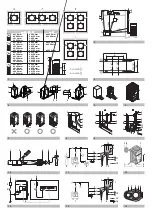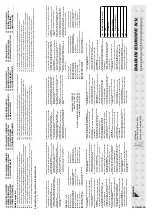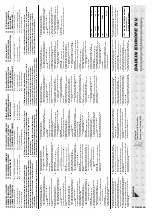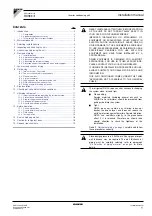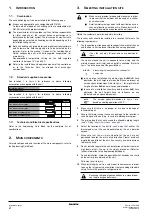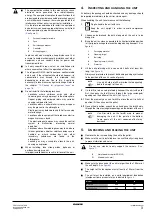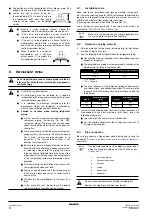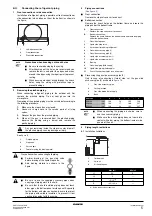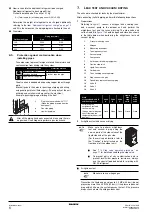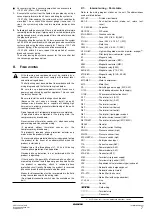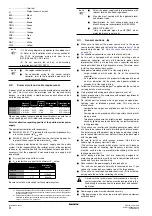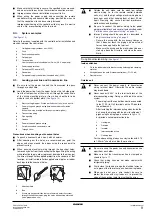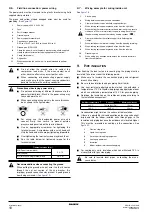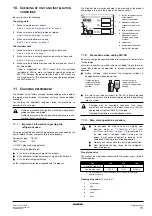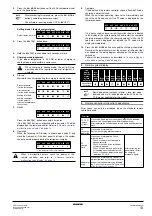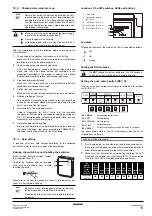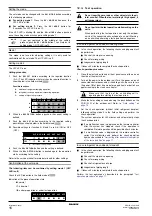
Installation manual
4
ERX125~250A7W1B
Inverter condensing unit
4PW30064-1D
■
Support the unit with a foundation of 67 mm wide or more. (The
support leg of the unit is 67 mm wide, see
■
Fasten the unit in place using four
foundation bolts M12. It is best to screw in
the foundation bolts until their length
remains 20
mm above the foundation
surface.
6.
R
EFRIGERANT
PIPING
6.1.
Installation tools
Make sure to use installation tools (gauge manifold charge hose,
etc.) that are exclusively used for R410A installations to withstand the
pressure and to prevent foreign materials (e.g. mineral oils such as
SUNISO and moisture) from mixing into the system.
(The screw specifications differ for R410A and R407C.)
Use a 2-stage vacuum pump with a non-return valve which can
evacuate to –100.7 kPa (5 Torr, –755 mm Hg).
6.2.
Selection of piping material
1.
Foreign materials inside pipes (including oils for fabrication)
must be 30 mg/10 m or less.
2.
Use the following material specification for refrigerant piping:
■
Construction material: phosphoric acid deoxidized seamless
copper for refrigerant.
■
Temper grade: use piping with temper grade in function of the
pipe diameter as listed in the table below.
■
The pipe thickness of the refrigerant piping should comply
with relevant local and national regulations. The minimal pipe
thickness for R410A piping must be in accordance with the
table below.
3.
In case the required pipe sizes (inch sizes) are not available, it is
also allowed to use other diameters (mm sizes), taken the
following into account:
■
select the pipe size nearest to the required size.
■
use the suitable adapters for the change-over from inch to
mm pipes (field supply).
6.3.
Pipe connection
Be sure to perform a nitrogen blow when brazing and to read the
paragraph
"Caution to be taken when brazing refrigerant piping" on
first.
■
Prepare a water drainage channel around the
foundation to drain waste water from around the unit.
■
If the unit is to be installed on a roof, check the
strength of the roof and its drainage facilities first.
■
If the unit is to be installed on a frame, install the
waterproofing board within a distance of 150 mm
under the unit in order to prevent infiltration of water
coming from under the unit.
■
When installed in a corrosive
environment, use a nut with
plastic washer (1) to protect the
nut tightening part from rust.
Do not insert fingers, rods or other objects into the air
inlet or outlet. When the fan is rotating at high speed, it
will cause injury.
■
Use R410A to add refrigerant.
■
All field piping must be installed by a licensed
refrigeration technician and must comply with relevant
local and national regulations.
■
It is forbidden to discharge refrigerant into the
atmosphere. Collect the refrigerant in accordance
with the freon collection and destruction law.
■
Caution to be taken when brazing refrigerant
piping
■
Do not use flux when brazing copper-to-copper
refrigerant piping. (Particularly for the HFC
refrigerant piping) Therefore, use the phosphor
copper brazing filler metal (BCuP) which does not
require flux.
■
Flux has extremely harmful influence on refrigerant
piping systems. For instance, if the chlorine based
flux is used, it will cause pipe corrosion or, in
particular, if the flux contains fluorine, it will
damage the refrigerant oil.
■
Be sure to perform a nitrogen blow when brazing.
Brazing without performing nitrogen replacement
or releasing nitrogen into the piping will create
large quantities of oxidized film on the inside of the
pipes, adversely affecting valves and compressors
in the refrigerating system and preventing normal
operation.
■
After completing the installation work, check that
the refrigerant gas does not leak.
■
Toxic gas may be produced if the refrigerant gas
leaks into the room and comes in contact with a
source of fire.
■
Ventilate the area immediately in the event of a
leak.
■
In the event of a leak, do not touch the leaked
refrigerant directly. Frostbite may be caused.
20 mm
1
NOTE
Make sure the pump oil does not flow oppositely into
the system while the pump is not working.
Pipe Ø
Temper grade of piping material
≤
15.9
O
≥
19.1
1/2H
O = Annealed
1/2H = Half hard
Pipe Ø
Minimal thickness
t (mm)
Pipe Ø
Minimal thickness
t (mm)
9.5
0.80
19.1
0.80
15.9
0.99
22.2
0.80
NOTE
The pressure regulator for the nitrogen released when
doing the brazing should be set to 0.02 MPa or less.
Do not use anti-oxidants when brazing the pipe joints.
Residue can clog pipes and break equipment.
1
Refrigerant piping
2
Location to be brazed
3
Nitrogen
4
Taping
5
Manual valve
6
Regulator


